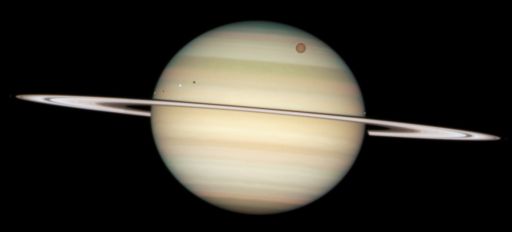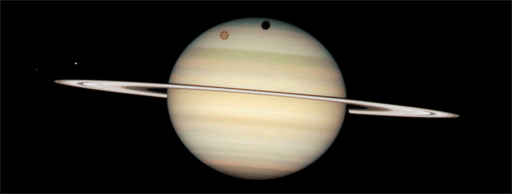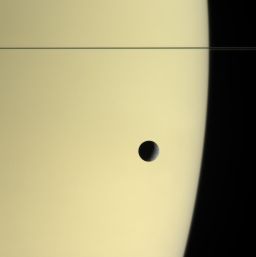Emily Lakdawalla • Mar 17, 2009
Hubble catches a quadruple transit

NASA, ESA, and the Hubble Heritage Team (STScI/AURA)
Hubble catches four moons on the face of Saturn
On February 24, 2009, Hubble's Wide Field and Planetary Camera 2 captured a rare quadruple transit: four moons crossed in front of Saturn's disk at the same time. The moons are, from left, white Enceladus and Dione (both of which are near the rings and casting shadows onto the planet); orange Titan; and white Mimas (just at the right-hand edge of the disk). We can only observe such transits from Earth for a brief period once every fifteen years as Earth nears and then crosses Saturn's ring plane.
NASA, ESA, and the Hubble Heritage Team (STScI/AURA)
Hubble catches four moons on the face of Saturn
The six images in this animation were captured on February 24, 2009, and show five moons circling Saturn, four of which cross the face of Saturn simultaneously in the fourth frame of the animation. The largest orange moon is Titan; to the right of Titan is Mimas; to the left of Titan are Enceladus and Dione. Very dimly visible in the first few frames of the animation (when it's viewed at full resolution) is Janus, just below the rings.The pictures are pretty, but what can we learn from them? I poked around on the website of the Space Telescope Science Institute to see if I could figure out what scientific purpose lay behind the transit photos. Here is the abstract of the proposal from a team of scientists led by Keith Noll:
We propose a program of 39 orbits to observe 6 targets with WFPC2 following a successful return to science using side B electronics. These observations will be used for Hubble Heritage releases in the months leading up to servicing mission 4 [currently scheduled for May 12, 2009]. Because of launch delays, our reserve of releasable images is growing dangerously slim. We are proposing here to replenish one of our important lines of communication with the public.We have carefully chosen targets that can efficiently use single pointings of WFPC2 to obtain images of visually striking and astrophysically interesting targets. Observations will reach high S/N [signal to noise] and will be dithered and subsampled to improve the resolution and pixel scale to near ACS/WFC3 quality at a modest cost in exposure time. Most of the observations will schedule in the interim between a return to science and the availability of new science proposals that may be selected in response to an interim call for proposals.
The Time is Now.
As a Planetary Defender, you’re part of our mission to decrease the risk of Earth being hit by an asteroid or comet.
Donate Today

 Explore Worlds
Explore Worlds Find Life
Find Life Defend Earth
Defend Earth


